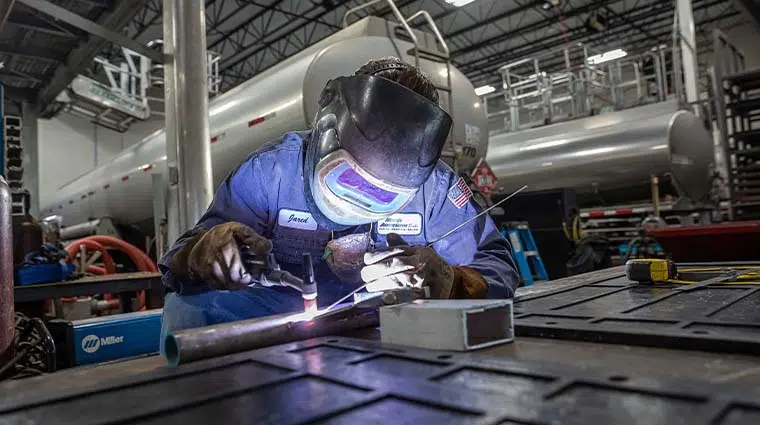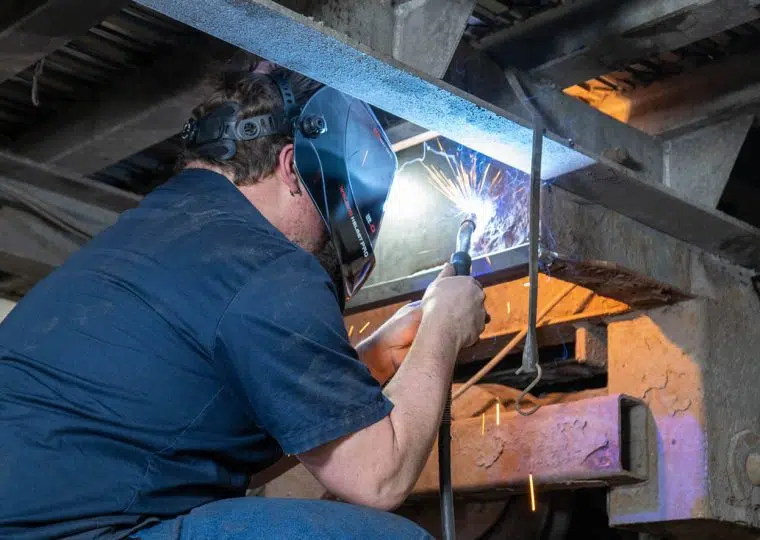Whether you’ve got a rusted patch or a cracked panel, welding is one of the best ways to complete bodywork for your truck. The best type of welding when it comes to auto repairs is MIG welding.
This is generally the go-to method because it can be done one-handed, is easy to learn, can be done on many types of metal, and is great for quick repairs. This is an excellent system for both novice and experienced welders.
If you’re new to the world of welding and want to know the ins and outs of MIG welding, you’re in the right place. We’ll take a closer look at everything you need to know before jumping in.
What Is MIG?
MIG stands for “metal inert gas.” MIG welding is also referred to as gas metal arc welding (GMAW). This type of welding requires Direct Current Positive Electrode (DCEP), or reverse polarity in order to heat the metals with the help of an arc. The arc is formed between the two surfaces that are being welded together.
The process uses a solid wire electrode that is continually heated and fed into the weld pool. As the base materials are melted together to form the joint, the gun feeds a shielding gas to provide protection to the weld pool from airborne contaminants.
This type of welding has been used in the United States for decades, with the first patent in 1949. Originally, it was used as a way to weld aluminum. At that time, the weld pool was protected by helium gas, which was readily available. In the UK, MIG grew in popularity starting in 1952, with argon as the shielding gas for welding carbon steels.
How Does MIG Welding Work?
The most common types of welding are MIG and Stick welding. They both produce quality welds, but they are used for different applications and the overall setups vary considerably. MIG is generally the easiest type of welding to learn, as you use an all-in-one welding gun. Stick can be quick to learn, but it takes a different level of skill to master overall.
Stick welding has been around since the 1930s, and many veteran welders still prefer this method. MIG does create a nice, straight, strong joint but if you’re welding metals thicker than ⅜ inch, Stick is preferred. MIG is also easier because it is faster, as Stick welding requires a longer warm-up period.
Stick also has more cleanup required on the finished product because the flux creates spatter that will need to be chipped away once the weld cools. The MIG’s shielding gas provides a much cleaner end result, blowing away any spatter.
MIG Welding Components
MIG welding is the most popular welding process globally for many reasons. It’s easy to use, affordable, fast, and simple to learn. Welders that use this method enjoy the versatility, as you can use it to repair a kid’s bike or the panels on your car, or you can use it to fabricate completely new items.
There are four main parts to a MIG welding setup, each necessary for easy and smooth operation:
Power Supply
Without a power supply, your MIG welding machine would be useless. This component controls multiple variables and has several functions and abilities. They are designed with a low maximum amperage output, which is ideal so you don’t have to worry that they pull too much power.
Torch
Also known as the “MIG welding gun,” the torch is the part that you hold and use to do your welds. If you end up with a cheap welder, you’ll likely be limited to using that specific brand with your torch, but more expensive brands can be used in a mix and match fashion, allowing you to build your ideal setup.
MIG Welding Wire
Without the welding wire, you’re not going to get very far. The welding wire is what melts in order to join the two pieces of metal together. It’s important to not skimp and go with the cheapest wire you can find. Many low-budget options have a harmful copper coating and others already have rust on them right out of the package. High-quality wire means stronger welds and less wear and tear to your torch’s tips.
Earth Clamp or Ground Clamp
Welding is done by creating an electrical circuit, and it’s crucial to have a quality ground clamp in order to complete the course. A clamp of poor quality can hinder the machine’s performance over time.
The MIG Welding Process
MIG welding uses a lot of electricity to create a weld. There is an electrical arc, also known as a short circuit, that is created between a positive anode (which is the electrode wire), and the negative cathode (the parent metal that you’re welding). The arc melts the electrode wire and creates the weld pool, which creates the weld. Once the heat is removed, the pool cools off and solidifies, creating a piece of fused metal, also known as a weld.
Modern welding machines are one-handed, as they have a spool-fed electrode wire that is fed into a co-axial supply line. While the wire is fed in, a shielding gas is also fed through the same supply line to the gun.
The gas is typically carbon dioxide, argon, or a mixture of the two. This gas is crucial to the strength of the weld, as it protects the weld pool from atmospheric gasses that would weaken the resulting weld.
Benefits Of MIG Welding
If you’re a novice welder, MIG is the way to go. There are multiple advantages to using a MIG welding setup, to begin with. Some of the biggest advantages include:
- Speed – Continuously-fed electrode allows for quick welding.
- Ease – One-handed operation and automation make it simple to use.
- Quality Welds – Flux-free and continual welding for clean straight welds.
- Long-Pass Welding – The continuous feed means fewer stops and starts so you can deposit more metal per pass.
- Cleaner Welding – No flux combined with the gas shield means less cleanup after you’re finished.
- Multiple Metals – Originally used for aluminum and magnesium, now can also be used with stainless steel, alloys, and mild steel.
- Portability – Traditional machines are hard to move around, but modern machines are easy to travel with.
Trust MIG Welding Professionals To Get Your Truck Or Trailer Today!
If your truck or trailer is in need of repairs, the best route is to contact a professional welder so they can get the job done right for you. Many repairs can be DIY projects, but the ideal repair route for a lot of metal-to-metal projects is welding.
The good news is that your friendly neighborhood welding professionals are here to help you out! No matter the project, we can get your vehicle back in safe operating condition in no time. Bring your truck in and talk to the MIG welding experts at NAT today!


